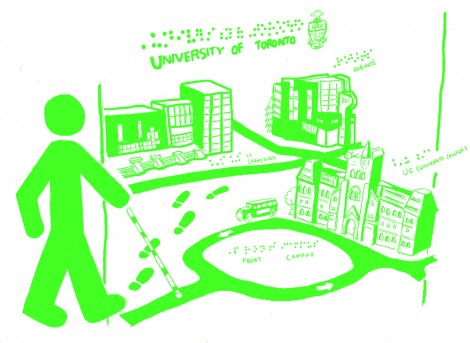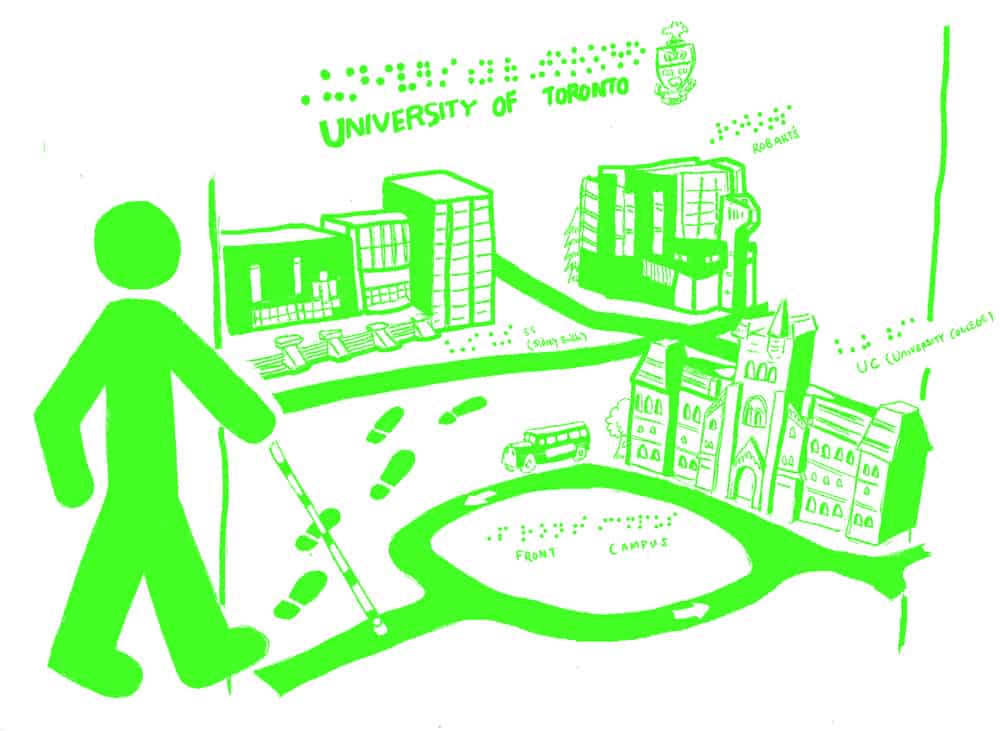Navigating around Toronto can be a hassle, even for the most able-bodied residents. But for those with physical disabilities, navigation becomes all the more difficult due to particular accessibility needs. Being in the heart of Toronto, U of T has unique accessibility strengths and weaknesses. Speaking from the perspective of a visually-impaired commuter with a visual acuity of 20/300 in my better eye, I will examine the areas in which the university and the City of Toronto excel at accessibility and the areas in which they need to improve.

TIMOTHY LAW/THE VARSITY
Accessibility on campus can generally be categorized into two areas: knowing where you are and where you are going, and physically getting there without injury. Visual impairment tends to create issues mainly with the former, though sometimes with the latter.
The university’s St. George campus is situated conveniently adjacent to four major thoroughfares: Bloor, University, College, and St. George. These streets are great for accessibility; they are walkable without worry of danger, and are far from confusing due to their simple and straightforward nature. Once one is off the main thoroughfares, however, the campus becomes a maze of winding streets and paths, with very poor signage to help guide people in the right direction. In particular, King’s College Circle and the Varsity Centre area are filled with paths that, while convenient for some, can be incredibly confusing when you cannot see where the path is and where it’s going.
The university has attempted to help fix this issue by providing maps of the campus. However, these maps are entirely inaccessible for two reasons: the maps are not at proper eye level and, moreover, use a font that is so tiny it is nearly impossible for anyone with vision problems to read.
U of T does, however, provide large signs with large print around campus that indicate many important buildings. This is a great concept and incredibly helpful, and could definitely be expanded for any areas that may not currently have signs.
Toronto’s subway, on the other hand, is by far the best form of transit for the visually impaired, because there is no worry about traffic on the road. That U of T’s downtown campus is serviced by four subway stops is a great thing. It makes it much easier to get around campus.
The buildings themselves in U of T are hit-and-miss in regards to accessibility, specifically those that house multiple classrooms, as opposed to larger single-room lecture halls. Some, such as Northrop Frye Hall and Simcoe Hall, are extremely accessible by providing easy to read signs on doors and directions to popular rooms. Others, such as Emmanuel College and University College, can be incredibly confusing due to poor lighting that makes halls difficult to navigate, and a lack of signage and visible room numbers that make finding classrooms a challenge.
The buildings that are not accessible, as one may expect, are the older ones. While I am the first person to say that historical buildings need to be preserved in the name of culture, there are changes that can be made to better serve students with disabilties without compromising buildings’ designs. Stronger lighting where possible — by using either stronger bulbs or more lights — solves many of the issues presented by old buildings, which are typically darker than newer ones. As well, signs that simply indicate the direction of ascending and descending room numbers — as opposed to signs on every door — do minimal damage to buildings; visually impaired students are able to count, after all.
It is important, as always, to recognize that everything, including accessibility, is relative. U of T has an amazing Accessibility Services department which, from my admittedly few experiences, advocates incredibly well for students with disabilities. That is not to say that U of T is perfect, but we are better than many other institutions.
Ultimately, the problem of accessibility at U of T comes down to the university’s age. Newer building additions are, by and large, accessible. Once we take the time and effort to bring older buildings and areas up to scratch, U of T can be a beacon for accessibility in Toronto.
Stephen Warner is a first-year student studying political science.


